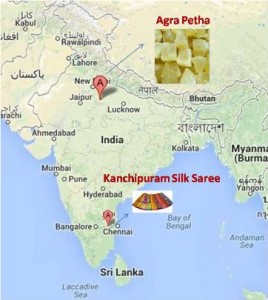Geographical Indication Tag
 Geographical Indication tag is an indicator on a product that a particular item has originated from a particular region only like the Kanchipuram Silk Saree, Alphanso Mango, Nagpuri Orange, Kolhapuri Chappal, Bikaneri Bhujia and Agra Petha etc.
Geographical Indication tag is an indicator on a product that a particular item has originated from a particular region only like the Kanchipuram Silk Saree, Alphanso Mango, Nagpuri Orange, Kolhapuri Chappal, Bikaneri Bhujia and Agra Petha etc.
So anybody from another part cannot sell an Agra Petha under the name.
GI tag helps in increasing brand visibility and increases the price of the product international market (because consumers in first world prefer such “exotic” items), it boosts exports, in certain cases, it can lead to extra earnings from tourism, and indirectly leads to sustainable Development.
A GI tag is different from a trademark because it indicates the geographical location of the product and is enjoyed by the entire community of the region whereas trademark is enjoyed by a single entity and is exclusive and not shared.
As per the TRIPS agreement, member nations have to respect geographical indications, and have to undertake measures to prevent violation of GI rights and another nation cannot impart trademark for the same product that enjoys GI status in a member nation. However, problems arise because laws are often country centric and it is difficult to punish somebody from Nepal who starts selling Agra Petha in America, nothing can be done in India. The process is cumbersome because a manual petition will need to be filed in America to protect the GI. (or India Government need pursue the matter via WTO) and to prevent such problems in future, again apply for GI status in America for “Protected Geographical Indication” (PGI). It costs money and effort to file again and again. This is a criticism of the mechanism and critics have suggested establishing a system wherein getting GI tag in one member country means protection everywhere.
Government of India enacted Geographical Indications of Goods (Registration and Protection) Act in 1999. (Came into force in 2003). Under this act, Registrar of Geographical Indications is the person that will take petitions for GI tag. An Intellectual Property Appellate Board hears appeals over the decisions of the Registrar of Geographical Indications. Geographical Indications Registry is there to keep the GI-database at Chennai. In India, GI can be given to agricultural, natural or manufactured goods originating in the said area.
It is significant to mention that GI rights are given to an association of persons, producers, organization and not to a single person because geographical indications are not built up by one individual but by a community of persons. Registration of a geographical indication is valid for a period of 10 years, needs to be renewed thereafter.
Customs authorities have the power to seize imported goods at the border, if there is prima facie evidence that a product is in infringing on the geographical indication of the rights holder. Sometimes countries go for a joint GI such as India and Pakistan that decided to go for a joint GI for Basmati globally but unfortunately talks collapsed and now while we are busy curtailing diplomatic relations, Philippines and other countries are selling their rice as “Basmati” in EU and USA! Somebody’s loss is somebody’s gain.
Madurai Malli have also been granted GI status. Madurai Malli is the name of the jasmine flower grown in Madurai region of Tamilnadu and mentioned in Tamil Literature since times immemorial. Price can be as high as Rs.2000 per kilogram.
For a list of GI’s of India, click here.
Image credit: Google Maps (Edited for illustration purpose), Featured image

